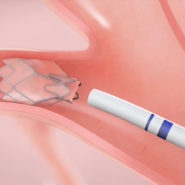REDWOOD CITY, Calif.–(BUSINESS WIRE)–Pulmonx® Corp. today announced its filing of a Premarket Approval (PMA) application with the U.S. Food and Drug Administration (FDA) for the Zephyr® Endobronchial Valve (EBV®), a minimally-invasive and removable device designed to treat severe emphysema, an advanced form of chronic obstructive disease (COPD). The Zephyr EBV is the only device designed for emphysema that has a clinically-validated diagnostic tool – the Chartis System® – which can identify likely responders in order to optimize patient outcomes.
“Assuming a positive reception from the FDA, we look forward to bringing the Zephyr EBV to U.S. pulmonologists and their emphysema patients who are desperately seeking new treatments.”
The filing was based on the successful execution of Pulmonx’s pivotal IDE trial, the LIBERATE Study, a landmark randomized controlled trial that enrolled 190 patients with severe emphysema at 24 centers in the U.S. and Europe. The trial endpoints at one year included measures of lung function, exercise tolerance and quality of life.
Three previous randomized controlled trials of the Zephyr EBV (TRANSFORM, IMPACT and STELVIO), in addition to LIBERATE, provide a robust body of evidence showing that the treatment improves breathing, exercise capacity and quality of life, while demonstrating long-term safety, in emphysema patients with little or no collateral ventilation as assessed with the Chartis System1,2,3.
Emphysema causes damage to the alveoli, the air sacs in the lungs, which allows air to escape and prevents patients from taking full breaths. This chronic breathlessness makes even the simplest daily activities difficult, such as washing, eating, walking and household chores, and often leads to patients becoming housebound and depressed. In fact, the quality of life for emphysema patients is worse than that for lung cancer4. As an incurable, progressive disease, emphysema can lead to early death without effective treatment options.
COPD is the third leading cause of death in the U.S., behind heart disease and cancer5. Because it is often underdiagnosed, it is estimated that between 12 million and 24 million Americans have COPD, costing the U.S. almost $50 billion in direct and indirect costs5. Almost five million Americans have a severe form of COPD known as emphysema5.
“We are proud to be leading the industry in developing rigorous and robust clinical evidence for this technology, which is consistently demonstrating the value of Zephyr EBVs in improving the lives of emphysema patients,” said Pulmonx CEO Glen French. “Assuming a positive reception from the FDA, we look forward to bringing the Zephyr EBV to U.S. pulmonologists and their emphysema patients who are desperately seeking new treatments.”
Zephyr EBVs are tiny, minimally-invasive, one-way valves placed via a flexible bronchoscope in airways in the lungs to block diseased regions and reduce lung hyperinflation. As a result, the remaining healthier regions of the lung can function more efficiently, enabling better breathing and an improved quality of life for patients.
Zephyr EBVs are widely used Europe, Australia, Asia and South America as a treatment for severe emphysema. Over the past 10 years, more than 50,000 Zephyr EBVs have been implanted globally in more than 12,000 patients. To view a video of the Zephyr EBV procedure, click here.
About Pulmonx
Based in Redwood City, California, and Neuchâtel, Switzerland, Pulmonx is an interventional pulmonology company focused on developing life-changing, cost-effective technologies that improve the lives of patients suffering from lung disease worldwide. For more information, visit www.pulmonx.com.
The Zephyr EBV is an investigational device in the United States. Limited by U.S. law to investigational use only.
- Klooster K, Ten Hacken NHT, Hartman JE, Kerstjens HAM, Van Rikxoort EM, Slebos DJ. Endobronchial valves for emphysema without interlobar collateral ventilation. N Engl J Med2015; 373:2325-2335.
2. Kemp SV, et al. A multicenter RCT of Zephyr Endobronchial Valve treatment in heterogeneous emphysema (TRANSFORM). Am J Respir Crit Care Med2017;https://doi.org/10.1164/rccm.201707-1327OC
3. Valipour A, et al. Endobronchial valve therapy in patients with homogeneous emphysema. Results from the IMPACT study. Am J Respir Crit Care Med 2016;194(9):1073-1082.
4. Gore JM, Brophy CJ, Greenstone MA. How well do we care for patients with end stage chronic obstructive pulmonary disease (COPD)? A comparison of palliative care and quality of life in COPD and lung cancer. Thorax 2000;55(12):1000-1006.
5. American Lung Association. Trends in COPD (Chronic Bronchitis and Emphysema): Morbidity and Mortality;March 2013. http://www.lung.org/assets/documents/research/copd-trend-report.pdf
Contacts
Chronic Communications
Michelle McAdam, 310-902-1274
[email protected]



